Rinchenpong(a silent valley), a hidden jewel of West Sikkim
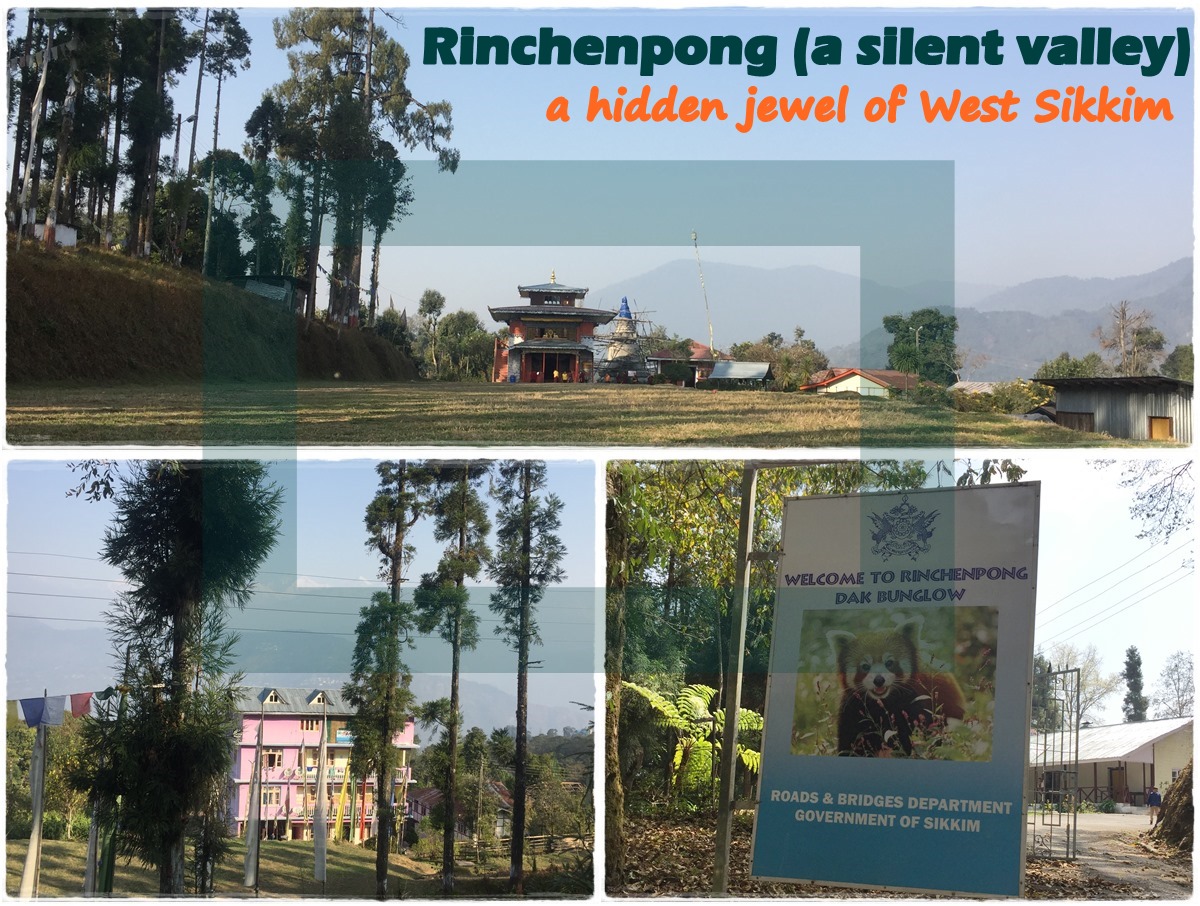
After a 2-day stay in Pelling, we reached Rinchenpong on March 18, 2018 as per our itinerary.
On March 18, 2018, after breakfast at the hotel in Pelling, we first stopped at the Singshore Suspension Bridge in a reserved cab. I visited the bridge before but never came in the early morning, so the atmosphere was very quiet, and we didn’t see anyone except a few locals. But the atmosphere was great. After that, we started our journey to reach our destination through Dentam Valley, and the route was filled with enchanting scenery. The amazing beauty of Dentum Valley fascinated us.
We next arrived in front of a bustling market known as Rinchenpong Bazar, but this was not our destination. So, we again followed an uphill road to reach the famous Rinchenpong Monastery from the market area.
Our car finally stopped at a monastery gate standing in front of flat land. From there, we saw the old Rinchenpong monastery directly, and our accommodation (Hotel Landscape, Matthi Gumpa-Rinchenpong) was next to the gate of the monastery. From our hotel premises, we could see the Kanchenjunga range, which fascinated us.
As a result, interest in exploring the hidden Rinchenpong increased several times.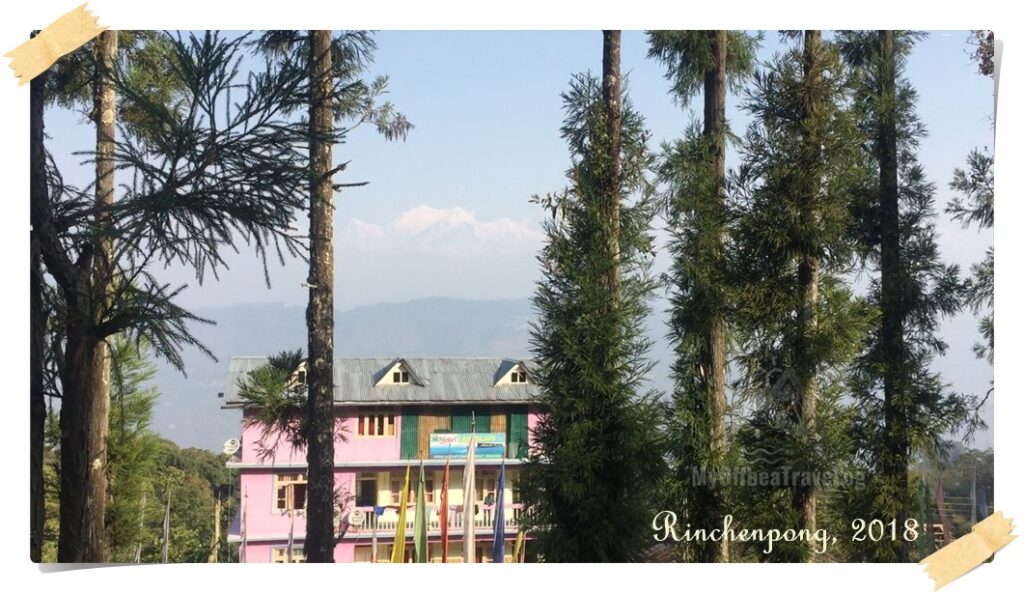
History of a lake in Rinchenpong – Poison Lake
This lake is locally known as Bikh Pokhari (or Pokhri). However, in the Lepcha language, it is called Neing Dah, where Neing means Poison and Dah means Lake.
When the British invaded the region in 1860, the primitive indigenous Lepcha people rebelled against British aggression. The lake was the only source of water for the British troops, and the Lepcha tribes used a mixture of poisonous herbs to poison the lake water. More than half of the British forces were wiped out after drinking the poisoned waters of that lake and were forced to retreat, which subsequently stopped the British invasion, and a compromise agreement was reached between the two sides.
Locals still consider the lake’s water poisonous and unusable, and they believe the lake is haunted. But from a historical point of view, this lake has been a symbol of resistance against foreign invasion. Currently, the lake is almost dry most of the year, but it is one of the main attractions in Rinchenpong.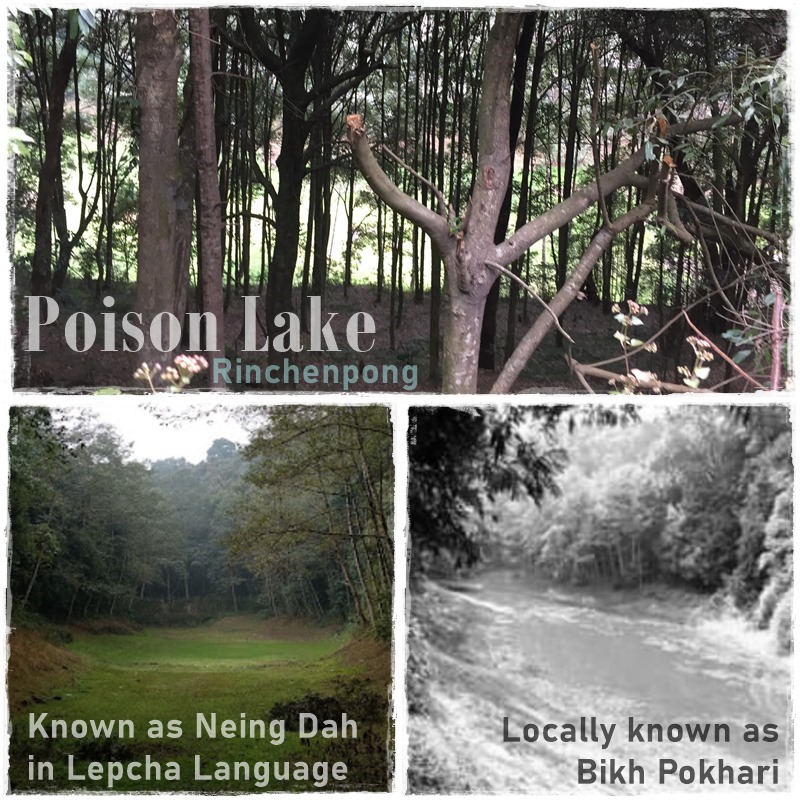
The cultural significance of Rinchenpong
Rinchenpong’s connection with a famous Nobel laureate
It is said that the Nobel laureate poet Rabindranath Tagore stayed in the Rinchenpong Dak Bungalow for some time, and during his stay here, he wrote one of his popular poems for his Gitanjali, titled Chitto Jetha Bhayshunyo (Where the mind is without fear).
A viewpoint near Rinchen Chholing Monastery is named Rabindra Smriti Van in honor of his arrival at Rinchenpong.
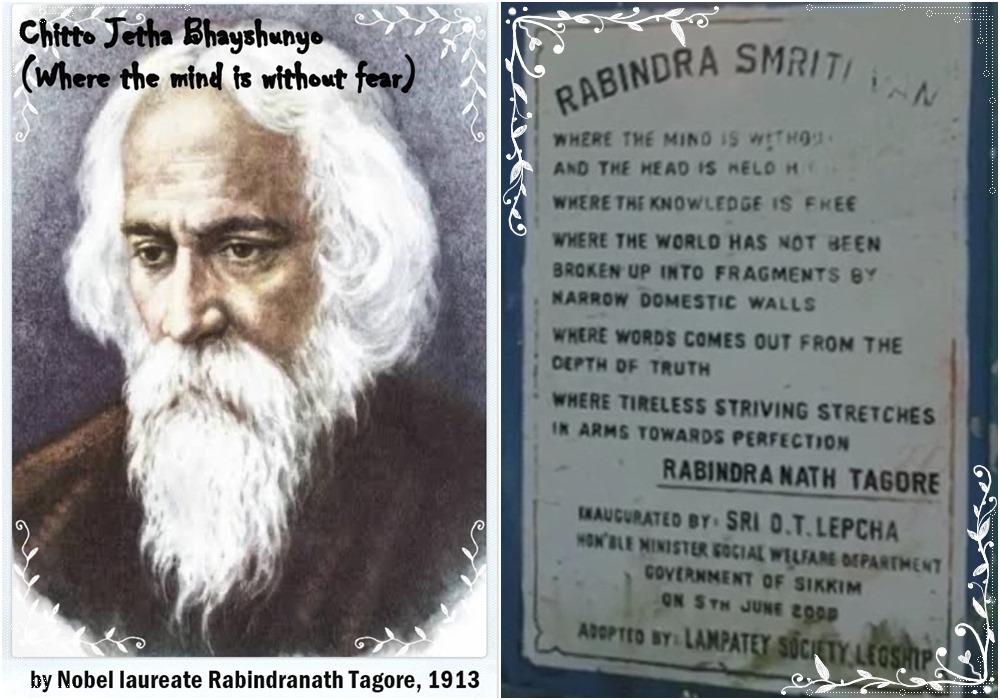
Why Rinchenpong’s two old monasteries are famous
Rinchenpong Monastery
Ngadakpa Lama established a monastery in 1730 in a silent valley called Rinchenpong, which is known today as Rinchenpong Monastery (Gey-Sanga-Yangtze Goompa). It is the 3rd oldest monastery in Sikkim, started with about 98 lamas.
The main significance of the Rinchenpong Monastery is the statue of a rare Ati Buddha (Adi-Buddha or Primordial Buddha) in the Yab-Yum position, which represents the universe and its natural wisdom.
This type of Buddha statue is found in very few monasteries, and in those monasteries, Tantric teachings are practiced along with Buddhism. The monastery is situated on a flat field with the monks’ quarters on one side and colorful prayer flags fluttering in the wind on the other.
Also, a mesmerizing view of Kanchenjunga from the monastery is a perfect blend of Sikkim’s ancient architecture and nature. The daily lives of young and child lamas will introduce you to another way of life.
Reesum Monastery
Rinchenpong has two famous monasteries, one of which is the nearly 300-year-old Reesum Monastery. In the Tibetan language, the word Reesum literally means Meeting Place Of Three Mountains. This monastery is located in a peaceful natural setting on a hilltop and is one of the most unexplored places in West Sikkim. There is an incredible 360-degree panoramic view from here.
This old monastery is beautifully decorated with Buddhist paintings, but currently the structure of the monastery is in shaky condition and needs renovation.
A 1.5-kilometer (approx.) forest path with stairs leads from Rinchenpong Monastery to this monastery, giving you the feel of a mini-hike. The silence of the hiking trail in the dense forest and the chirping of birds – a melodious world unfolds.
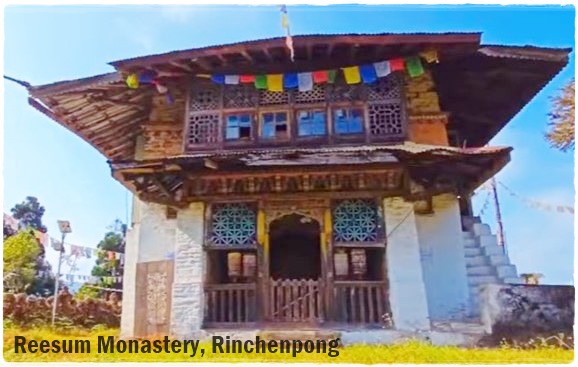
Where is Rinchenpong Located?
Altitude & Location: At around 5,576 ft above the sea level. This offbeat is located in the West District of Sikkim state, India and belongs to the Soreng Subdivision.
Essential Information of Rinchenpong
Nearest Airport:
International: Bagdogra Airport (IXB), WB
Domestic: Pakyong Airport (PKY), Sikkim
Nearest Main Railway Station: NJP
Nearest Town: Pelling
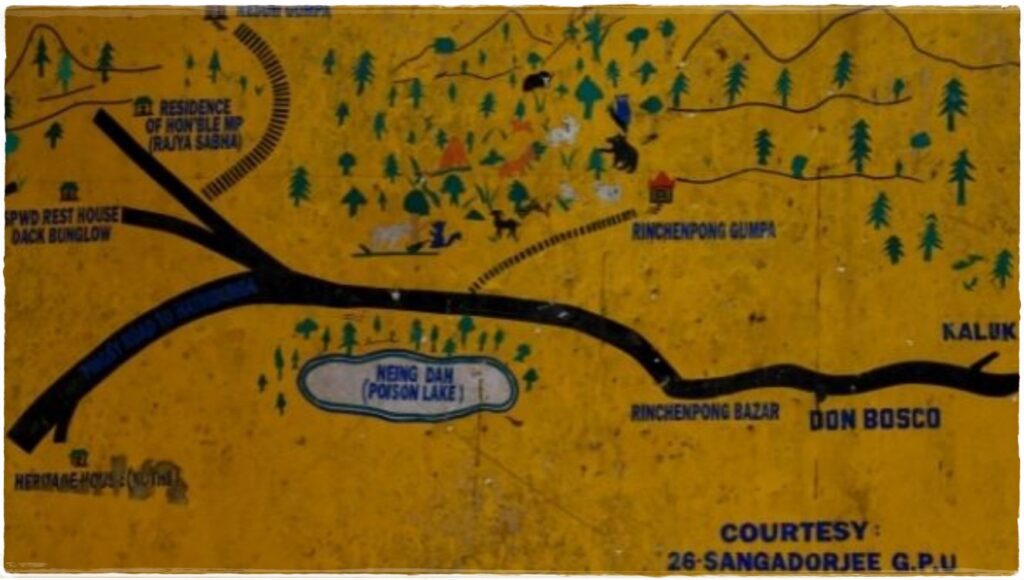
Distance from Rinchenpong (Approx. Measurement)
| Destination | Distance (KMs) |
| Gangtok | 120 |
| NJP Railway Station | 126 |
| Bagdogra Airport (IXB) | 133 |
| Siliguri | 122 |
| Pakyong Airport (PKY) | 102 |
| Yuksom | 49 |
| Singshore Suspension Bridge | 27 |
| Pelling | 46 |
| Khecheopalri Lake | 64 |
| Ravangla | 39 |
| Chayatal | 23 |
| Kaluk | 3 |
| Geyzing | 25 |
| Namchi | 43 |
| Hee Burmiok | 8 |
| Pemayangtse Monastery | 41 |
How to Reach
Rinchenpong is well connected by road to various parts of Sikkim and West Bengal. You can easily reach here by hiring a reserve cab from NJP, Siliguri, Bagdogra, and Gangtok.
But direct shared cabs are not available from Siliguri and NJP to reach here.
The most convenient route to Rinchenpong is to first take a shared cab or a Sikkim government bus from Siliguri’s SNT bus stand to reach Jorethang via Melli Checkpost. After that, take a shared cab from the Jorethang bus stand to reach Rinchenpong via Kaluk.
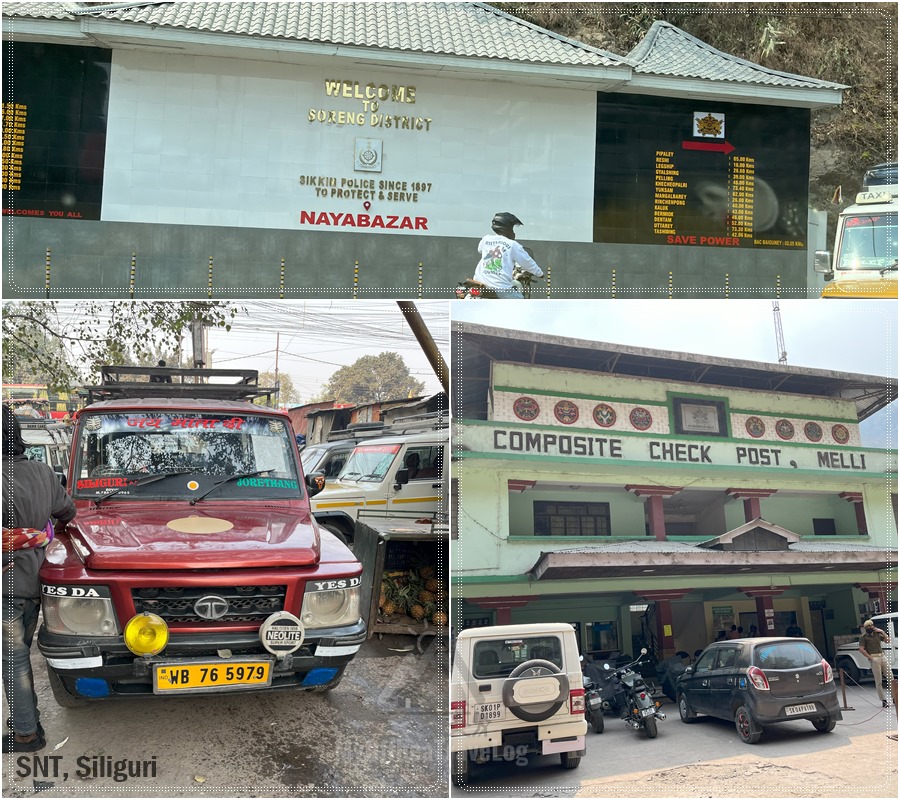
The journey from Pelling to Rinchenpong is very charming and scenic. This route passes through the Singshore Suspension Bridge, Dentam Valley, and finally reaches Rinchenpong.
Note: If you request your hotel or homestay for pickup and drop-off, they can also arrange the vehicle.
Local Medical Facility
Rinchenpong PHC is the main center of the medical system here.
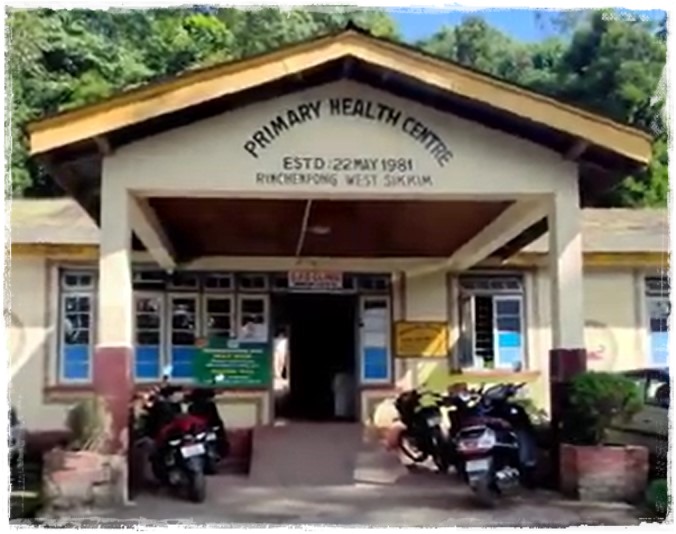
Local people and their livelihood
Various ethnic groups populate Rinchenpong, which has a small population. The population composition here includes communities such as Bhutia, Lepcha, Limboo, and Nepali, continuing Sikkim’s tradition of being home to a multi-ethnic, multi-cultural, and multi-lingual population.
Rinchenpong’s religious identity is diverse, reflecting the coexistence of different religions. Along with Buddhism and Hinduism, Christianity is also practiced.
Nepali, Bhutia, and Hindi—these languages are mostly used here. But some of them can also speak and understand English. Hence, tourists do not have to face language problems here and can easily communicate with the locals.
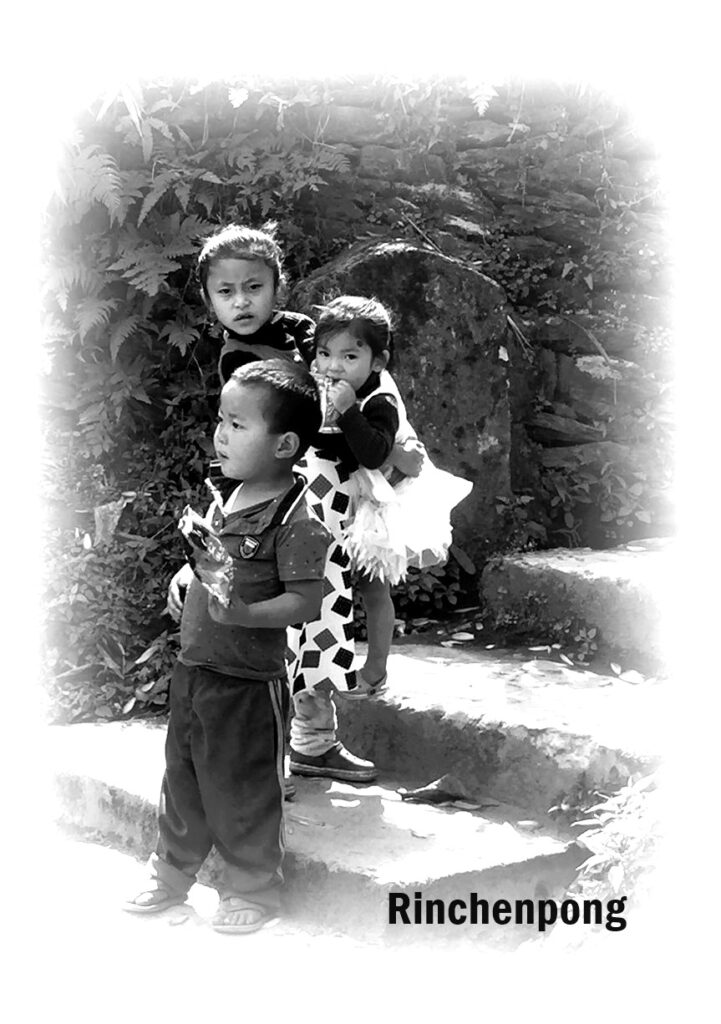
Agriculture is an important occupation for the people of Rinchenpong. They cultivate paddy, maize, turmeric, and black cardamom using terrace farming and organic methods. Besides, they cultivate kiwi, oranges, and other fruits; that’s why some organic farms have been established here.Also,locals are involved in animal husbandry.
However, currently, tourism is also playing a significant role in the development of the rural economy of the region.
Hence, nowadays, some villagers are providing homestay and farmstay facilities for tourists. Local handicrafts (traditional weaving and carpentry) contribute to the local economy.
What to do
- Village Walk: Explore the charming village by walking amidst beautiful natural surroundings that will help you understand the local lifestyle.
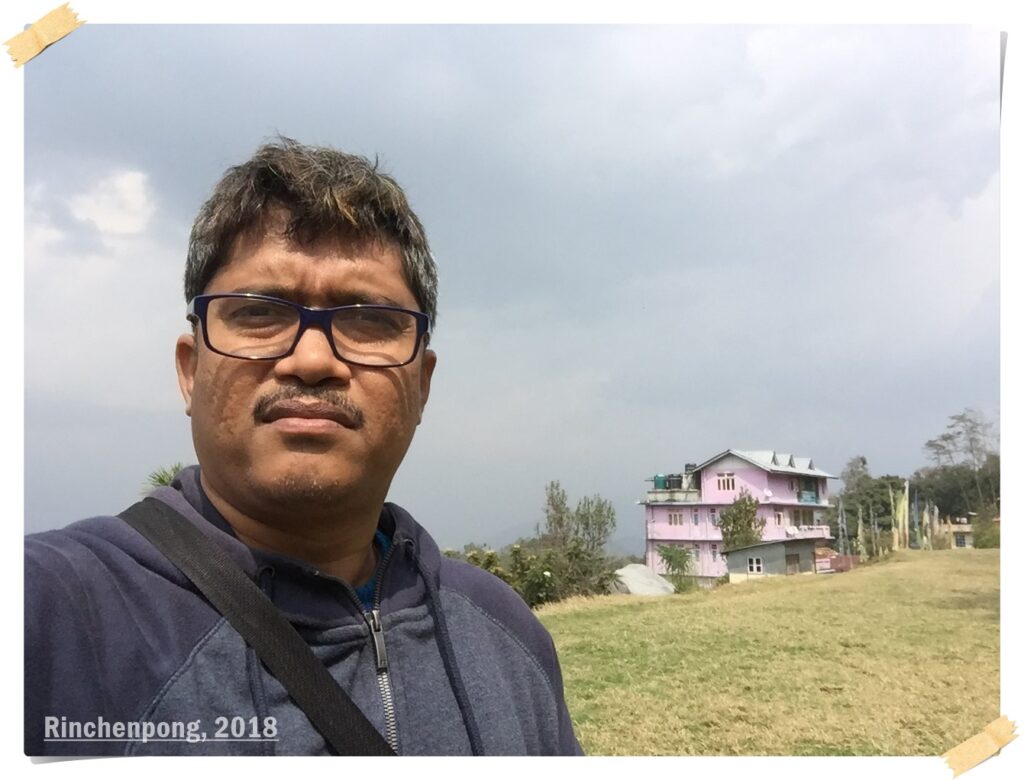
- Monastery Tour: The beautiful and serene surroundings of the monasteries make Rinchenpong an amazing place to seek peace of mind. You can easily feel the closeness of God within any monastery premises.
- Bird Watching: Rinchenpong and its surroundings have a rich diversity of various bird species, so this region is an ideal destination for bird watchers.
- Visit Rinchenpong Bazaar (Local Market): This is a lively place that is an amalgamation of local culture and business. This market showcases traditional Sikkimese handicrafts, traditional attire, souvenirs, etc. This place is not just a place for shopping but also a meeting place for the communities and their interesting traditions. So, you must visit this market.
- Visit the famous organic farms in Rinchenpong and taste the various organic fruit wines and local delicacies.
- This offbeat destination is the Perfect Place to Relax and Rejuvenate. So, simply relax in the peaceful natural surroundings of Rinchenpong.
- From Rinchenpong, plan trips to nearby offbeat places like Kaluk, Hee Bermiok, Chayatal, Dentam, Pelling, and Uttarey.
- Trekking & Hiking.
Attractions
Rinchen Chholing Monastery
This monastery is locally known as Gurung Gompha and is located at Meghi-Dara, which is near to Rinchenpong Bazar. The monastery was built by the Gurung Buddhist Society in 1996 over the ruined site of an old Tshamkhang (a hut for hermitage, where a single monk goes to reside for a period of three to six months.).
Many of its developments have taken place under the joint initiative of the Government of Sikkim and the Gurung Buddhist Society.
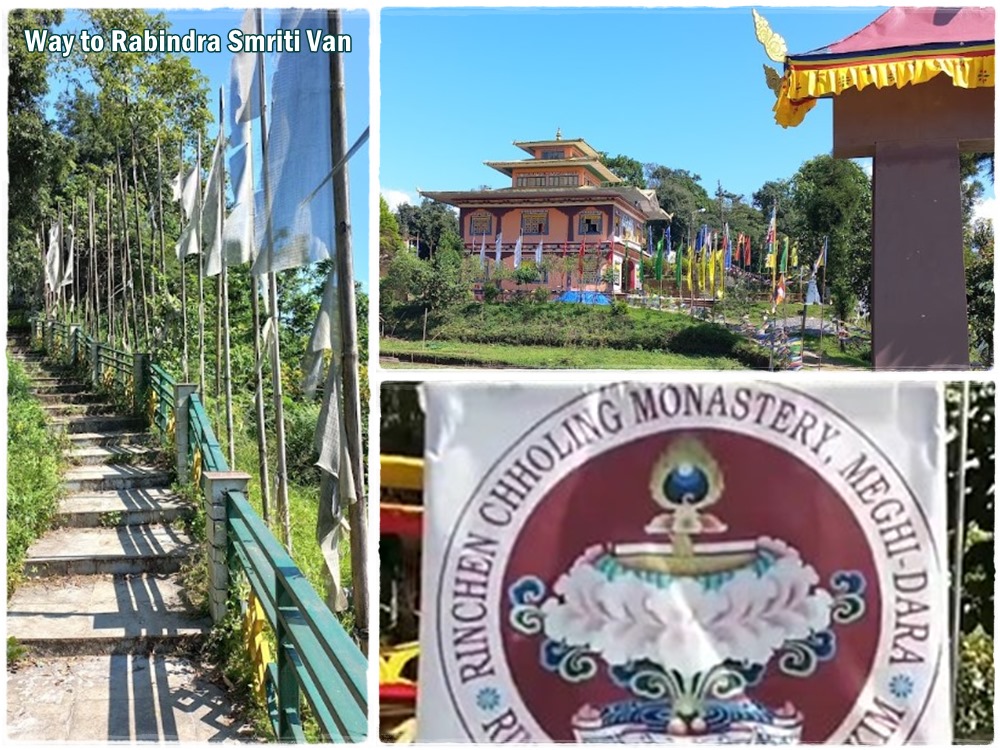
Rabindra Smriti Van
A popular viewpoint of Rinchenpong, which is dedicated to the famous Nobel laureate Rabindranath Tagore. Tourists can reach the viewpoint by climbing stone steps just opposite the Rinchen Chholing Monastery.
A stone tablet contains verses from Rabindranath Tagore’s Gitanjali. Because the great poet spent some days of his life here and wrote a poem. A plaque was erected to commemorate his arrival in this offbeat Sikkimese village. At present, the Sikkim government has undertaken various beautification projects after evaluating the historical importance of this viewpoint, which will increase the attraction of tourists to Rinchenpong in the future.
This viewpoint is filled with rhododendron, varieties of orchids, and other seasonal flowers and is an ideal spot for sunrise and sunset. The flowing Rangeet River (a tributary of the Teesta River) can be seen from here.
Rinchenpong Dak Bunglow
This heritage Dak Bungalow is an old cottage-style wooden bungalow built by the British for the accommodation of some high-ranking officials of the East India Company, important political representatives, and dignitaries.
Apart from the Bengali poet Rabindra Nath Tagore, a prominent British botanist, Sir Joseph Dalton Hooker, stayed in this heritage bungalow during his visit to Barsey (Varsey) Rhododendron Sanctuary in the 1800s.
This bungalow mainly consists of 3 rooms with an attached toilet, a long front porch, and a fireplace.
The bungalow is surrounded by various seasonal flowers and dense alpine trees, and the tranquility and natural beauty of the surroundings attract tourists immensely. At present, the bungalow is being maintained by the government of Sikkim.
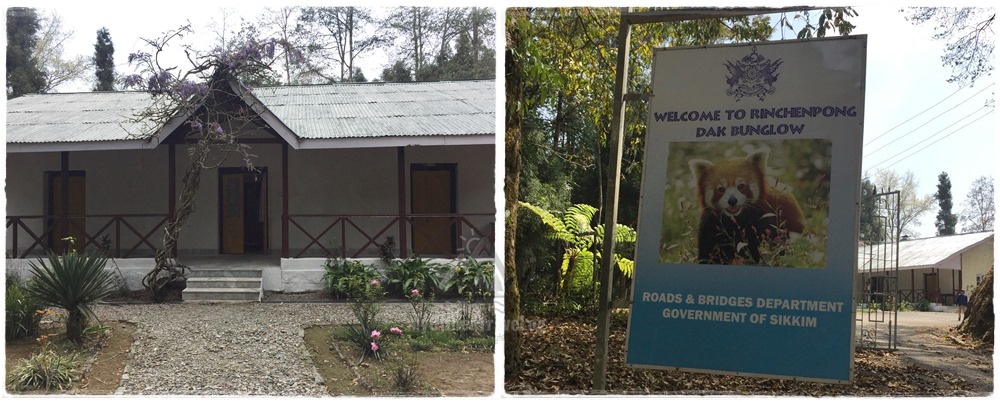
Sightseeing
Singshore Suspension Bridge: This famous suspension bridge is said to be the highest bridge in Sikkim and the second highest bridge in Asia. It is over 100 meters high and connects two gorges in West Sikkim.
Chayatal: This offbeat destination is famous for a 36-foot bronze statue of Mahatma Sirijunga Teyongsi and the lake.
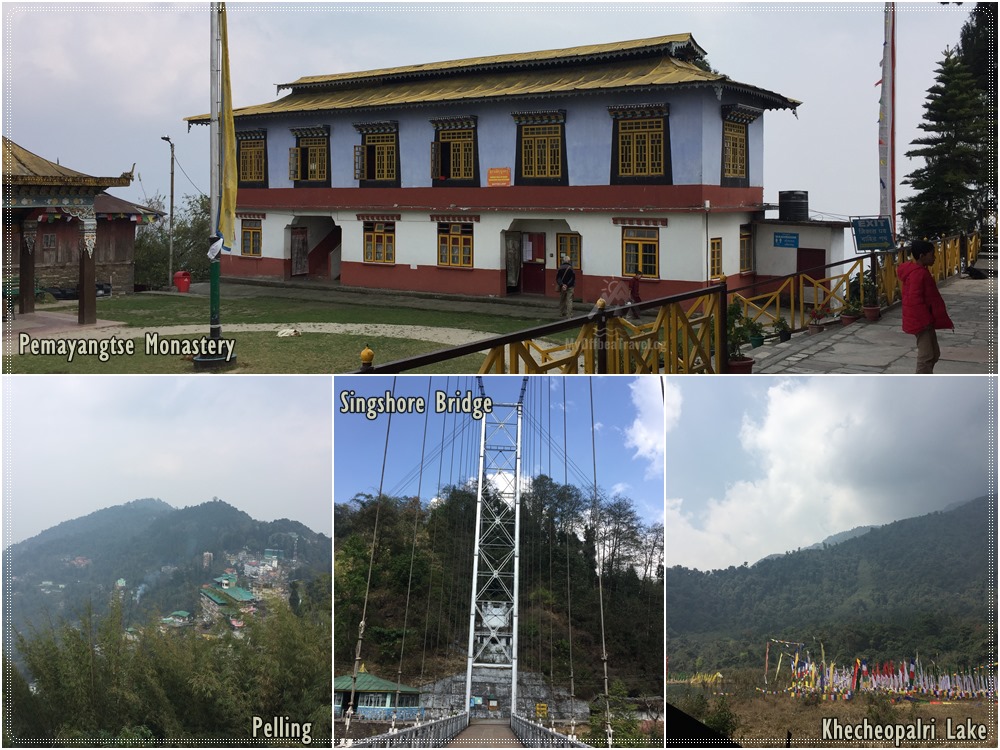
Barsey (Varsey) Rhododendron Sanctuary: The sanctuary is famous for its variety of rhododendrons. The sanctuary covers about 104 sq km in the Singalila range of West Sikkim and is a natural habitat for a number of wild animals, including the rare red panda. Hence, this sanctuary is one of the tourist attractions, and many tourists visit during the rhododendron blooming season (March to April).
Khecheopalri Lake: One of Holiest Lakes in Sikkim.
Pemayangtse Monastery, near Pelling: This is one of the oldest and most famous monasteries in Sikkim. Lama Lhatsun Chempo constructed and planned this Buddhist monastery in 1705.
Hee Water Garden: This popular tourist spot is located on the banks of the Hee Khola. One of the main attractions of this garden is the largest Buddhist prayer wheel, which is powered by water. Also, you can see a swimming pool, a cafeteria, and a Shiva temple in this beautiful garden.
Festivals
Rinchenpong celebrates popular festivals like Losar, Dasain, Tihar, Losoong, Sakewa, etc. Apart from these popluar festivals, Rinchenpong also celebrates special festivals.
Kagyed Chaam Festival: A religious masked dance held in monasteries that falls on the 28th and 29th days of the tenth month of the Tibetan calendar (which falls in December in the English calendar).
The famous flower festival of Sikkim is also celebrated here.
Where to Stay
There are a few budget and deluxe hotels in Rinchengpong, but currently the best choices for tourists are homestays and farmstays.
These types of new concepts of stay promote eco-tourism among tourists with the help of the tourism department of Sikkim and local people.
Some homestays and farmstays serve only ethnic dishes. So, don’t expect this type of ethnic food from any hotel. Also, homestays and farmstays can arrange transportation facilities like hotels. Locals can organize trekking and hiking for adventure enthusiasts if required. You can book from various online hotel or homestay booking sites or communicate with them directly through their valid contact numbers.
Below are the details of the accommodations during travel in Rinchenpong.
- Hotel Landscape,
Matthi Gumpa-Rinchenpong
Beside Rinchenpong MonasteryIn March 2018, we stayed at this hotel and booked it through a travel agent in Kolkata, as I didn’t have much information about homestays in Rinchenpong at that time.
Mr. and Mrs. Basumallik, a Bengali couple, permanently shifted to Rinchenpong from Kolkata and ran the hotel at that time. Their behavior was very sincere.
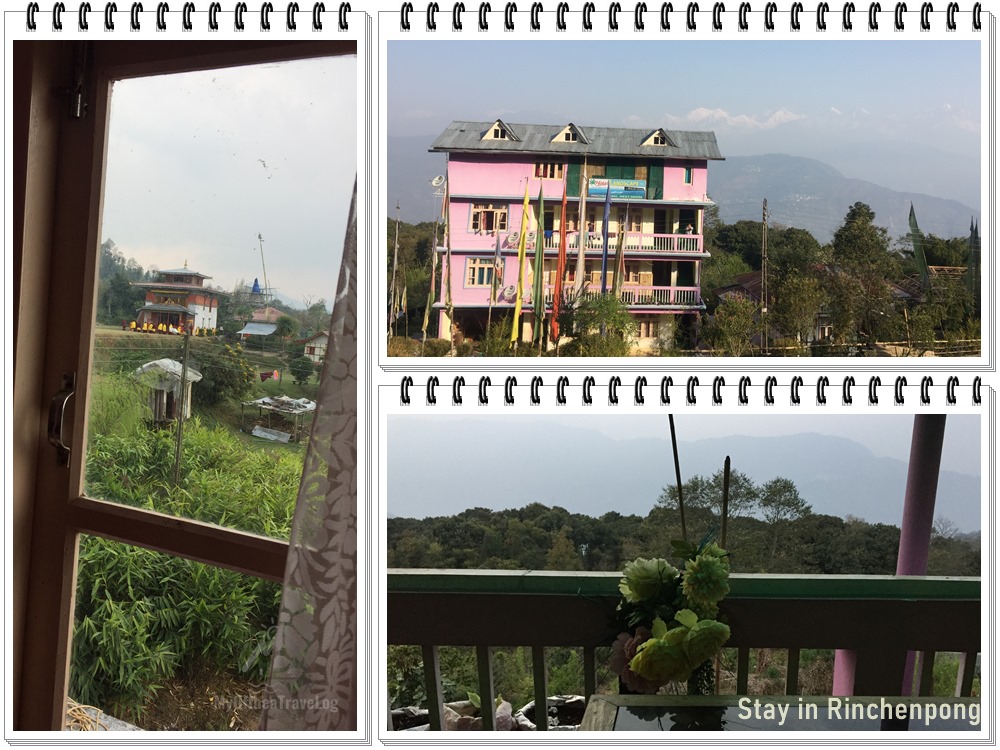
But what I liked most was its location (which is very close to the Rinchenpong Monastery) and the peaceful surroundings. The rooftop restaurant of this hotel offers a wonderful view of Kanchenjunga. It is an ideal place to enjoy the view of Kanchenjunga with a cup of hot coffee and momos. The rooms have a wonderful view of the entire front grounds of Rinchenpong Monastery and Mt. Kanchenjunga Range, which is simply magnificent. This hotel provides parking facilities.
But as per my experience, it is better to call it a homestay rather than a hotel.
- Azing’s Model Farm,Hathidunga, Rinchenpong
A Pure Organic Farm
Host & Founder: Mr. Azing Lepcha
Phone: +91 9734196478,9434117620
This organic farm is spread over about 5 acres of land, which is a success story of Mr. Azing Lepcha’s self-sufficiency, whose sole occupation is agriculture and horticulture. Also, he has done an excellent job in animal husbandry, fisheries, and beekeeping.
 The farm produces various home-made organic wines and honey, attracting many tourists.
The farm produces various home-made organic wines and honey, attracting many tourists.
It is a wonderful place to spend vacation time in the lap of the mountains. This popular farm also has homestay facilities.
Improved livelihood through self-reliance is a great example for the youth of rural India.
- Yangsum Heritage Farm
An offbeat experiential accommodation
Yangsum Chingthang, 2 KM away from Rinchenpong Bazar
Phone: +91-9733085196,9434179029
A farm spread over 44 acres consisting of pine, chestnut, magnolia, rhododendron, and other mixed forests. Thendup Tashi and his wife run the rustic heritage farmhouse, built in 1833 and renovated in 1966. The farm is completely organic and grows cardamom, avocado, orange, corn, millet, potato, ginger, turmeric, etc. This organic farm also cultivates various seasonal vegetables, such as cauliflower, cabbage, tomatoes, and peas.
- Rani’s Kitchen Homestay
Phone: +91 9733249736 - Orchid Villa Homestay
Host & Owner: Mr. Bhaskar Gurung
Phone: +91 84361 05158
- Hotel Rinchenpong Nest
near Rabindra Smriti Van, Meghi Dara, Rinchenpong
Phone: +91 7432021509

I have only shared with you my memorable experiences with homestay or Hotel owners, drivers, or tour guides while traveling, but your experience may not be the same as mine. Hence, I have no responsibility in that case. I am just sharing information only.
-
-
- When you visit a monastery, maintain silence.
- Smoking, and spitting are not permitted at any monastery premises.
- Do not do any photography inside the monastery.
- Single-use plastic (SUP) is banned in Sikkim to save the environment, so don’t ask for plastic bags when buying anything at local shops.
- Carry a reusable water bottle that you can refill.
- Be respectful of local traditions.
- Do not litter.
-
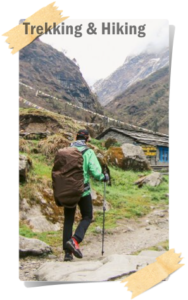
As there are various trekking trails in and around Rinchenpong, the homestays and hotels here offer adventure activities like hiking and short treks for adventure enthusiasts.
A hike(takes 3-4 hrs) through the jungle trails to visit Rinchenpong’s popular local spots and monasteries, mingle with local people working in the fields, or talk with them during rest, which will give you a lot of energy and relieve the fatigue of the hiking.
A Day Trek: Rinchenpong is located in the buffer zone of the famous Barsey (Varsey) Rhododendron Sanctuary, and the distance is 30 km from the sanctuary. Use the hilly-jungle trail to reach the sanctuary from here. Trekking through the trails filled with different types of colorful, blooming rhododendrons is a great attraction.
Rinchenpong – Soreng Trek (Timing: April-June or October-December): This popular trekking route follows Kaluk → Rinchenpong Dak bungalow → Rinchenpong Monastery → Kaluk → Jhandi Dara (which is middle of Sribadam Forest) → Soreng.
Weather & Best Time to Visit
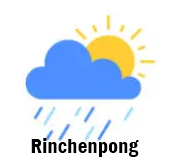
The months of March and April mark the flowering season and the ideal time to visit Barsi Rhododendron Sanctuary, located around 30 km from Rinchenpong, as red, pink, and white rhododendrons fill the surroundings. Besides, other flowers like orchids and magnolias also bloom during this season. The weather is usually pleasant, but there are occasional drizzles.
The rainy season extends from mid-June to about the end of September, but the heaviest rainfall occurs in August. Local roads are landslide-prone, so be careful while traveling during monsoons.
However, the unique form of monsoons attracts many adventure-loving tourists.
Autumn and winter (October to February) have the clearest skies and are the best times to view Mt. Kanchenjunga. During this time, Rinchenpong offers an abundance of delicious fruits, such as oranges, cherries, and kiwis. Winter is not as severe as in other parts of Sikkim, and Rinchenpong does not experience snowfall.
The best time to visit: March to April or October to February
![]() You can see some selected stunning photos & videos by clicking on the blog’s Instagram, Facebook and X(Twitter). Also, click the Gallery Section of this blog for only photos. I hope you will like those.
You can see some selected stunning photos & videos by clicking on the blog’s Instagram, Facebook and X(Twitter). Also, click the Gallery Section of this blog for only photos. I hope you will like those.
 Joseph Dalton Hooker is considered one of the greatest botanists of the nineteenth century and was a close friend of Charles Darwin. His name is also associated with the Barsey (Varsey) Rhododendron Sanctuary, as he thoroughly documented the flora and fauna of this Himalayan region.
Joseph Dalton Hooker is considered one of the greatest botanists of the nineteenth century and was a close friend of Charles Darwin. His name is also associated with the Barsey (Varsey) Rhododendron Sanctuary, as he thoroughly documented the flora and fauna of this Himalayan region.
In 1849, he wrote an authoritative text on the rhododendrons of Sikkim titled The Rhododendrons of Sikkim-Himalaya.
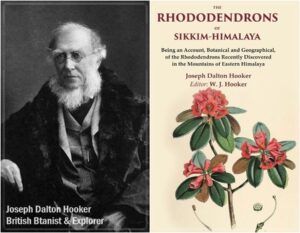
Archive
Tags


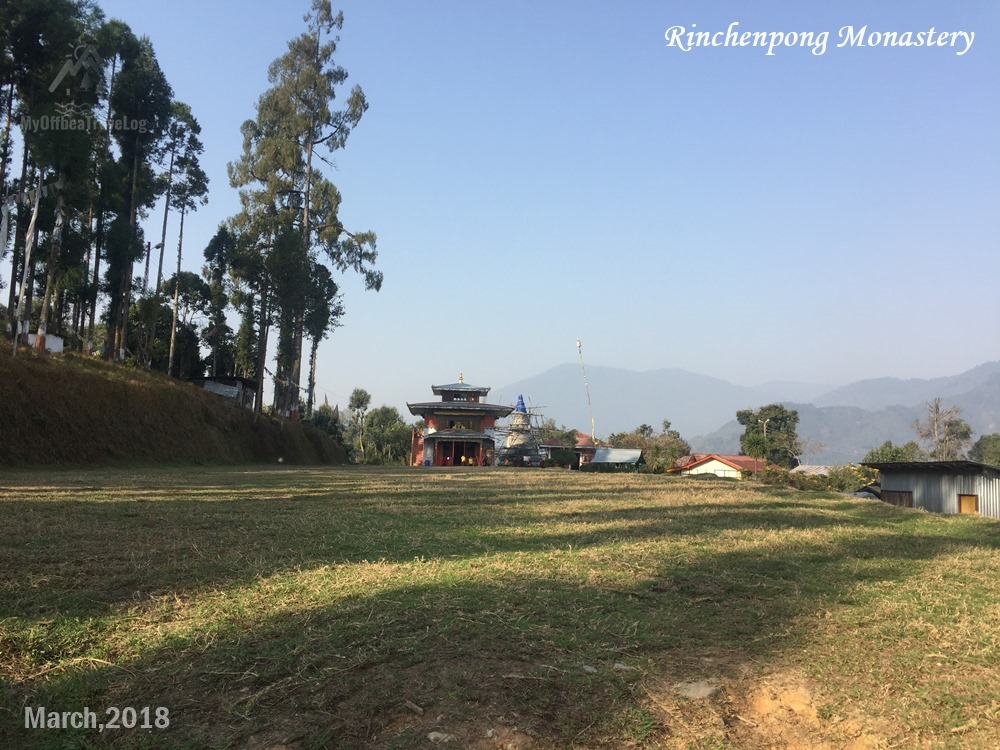

Awesome visualisation as you narrate the landscape. This place always urge for a deep breadth when one come in front of the foggy hills and Kanchengengha where you exhale out all stress to nature. As you had mentioned about walk and trek one should be mindful of the LEECHES and slippery stairs which are additional to the adventure. These stairs vanishes in the mild forest and greenery. Wish you all the best and keep going, keep exploring the best places. Even Noble laureate enjoyed this serene beauty to pen down his best. Appreciate your effort and keep blogging.
Hi Arnab, I am flattered by your words. Your appreciation will surely motivate me to write better blogs. Thank you so much!
Your blogs are always full of information about the place and the inhabitants.
Thank you very much!
Amazing 👍
Thank you very much for your inspiration.